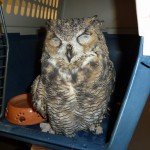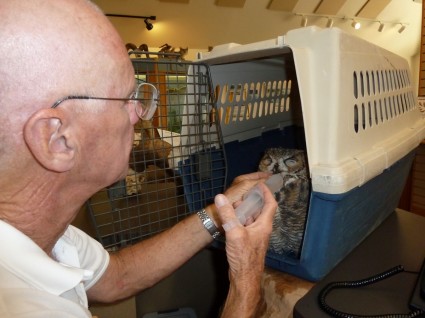An owl sitting in the middle of the road is not natural. So when someone reported a great horned owl on the road leading toward Imperial National Wildlife Refuge, biologist Joe Barnett investigated.
When Joe arrived at the scene, he discovered that a Refuge fireman had already gathered the owl in his jacket. After transferring the bird to a crate, Joe checked it for injuries. “The owl was barely responsive and was having a very difficult time breathing,” says Joe.
Lethargic and docile, its eyes swollen shut, the owl’s cheek appeared inflamed. A segment of an insect protruded from its beak. “I pulled it out to reveal it was the stinger from a giant hairy scorpion,” says Joe, who searched the area and located several segments of the remainder of the scorpion.
After placing the crate in his truck, Joe covered it to keep the owl calm. When he returned to the Refuge visitor center, Joe set the crate on the desk and opened the door. Sitting inside, the great horned owl continued to squeeze its eyes shut, making no motion to flap its wings or escape in any way. “I think it’s a young owl,” said Joe. “Its breathing has improved since I first found it. It probably needs some water.”
Hydrating
Chuck located a syringe, filled it with water, and sat in front of the owl. With two fingers, he gently opened the beak and inserted the tip of the syringe he’d filled. As he pushed the plunger, water flowed into the owl’s mouth, some of it spilling onto the desk. But the owl swallowed most of the water. Then the bird opened its eyes and shook its head before returning to its oblivious state.
“If it survives, it probably won’t go after a scorpion again!” I said.
But there was no assurance that it would survive. The great horned owl needed help. Joe once again placed the crate and owl in his truck and drove to town with the address of a raptor rehabilitator — the owl’s best hope for survival.




Keep us informed on the owls progress. I hope it makes it.